
Morocco and the Jebel Sahro
Words and pictures, a 14 day walking tour of the Jebel Sahro with Exodus Feb 2003. The group comprised 15 of us of mixed ages, backgrounds and nationalities, 6 mules, 2 Moroccan guides, cook, and an assortment of muleteers.
Unlike the genuine traveller, unlike American Donna, I didn't keep a diary, and that in combination with my venerable years has left a certain scope for omissions in this brief travelogue. However, between my recollections and my photographs and with assistance the from Sue and her tiny diary I hope that I have patched together a little of the flavour and atmosphere of our trek through the wonderful region of Morocco.
The itinerary allowed for a day and a half exploring Marrakech, only earned however after 10 days under canvas, trekking in some remote territory of the Jebel Sahro region Southeast of the main Atlas group. We walked every day, and though a couple of days were less than 3 hours there was a 9 hour day and a couple of 7 hour ones thrown in for good measure. Fortunately, the mules carried the main luggage for us and we usually arrived at our evening venue to find the base camp set up and tea water on the boil. Drinking and washing water was carried by the mules, sometimes more than one day supply as there was not always water to be had at the evening camp. Drinking water was iodine treated to protect us against Guardia and Amoebic dysentery amongst other nasties; ascorbic acid tablets got rid of most of the taste though some chose to carry portable water filtration systems to bypass the whole process.
The Jebel Sahro is a beautiful part of the world, but barren, the scenery sometimes resembling a crinkled brown paper bag. Occasionally, hidden within the creases of the landscape were startling oases of mud dwellings amid patchwork fields of vivid green barley, date palms and orchards of figs and apricots. A sure sign that there was a well nearby to allow irrigation. No water, no life.
In the summer months daytime temperature can rise into the mid 40's, too hot even for the locals and far too hot for trekking. Our temperatures at the end of February 2003 ranged between -3 at night to a pleasant +20 celsius in the daytime. Despite the moderate air temperature, the sun was quite powerful and there were a few pink faces about.
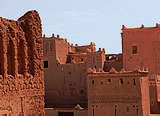
So how did it all begin? After a night at the Al-Kabir hotel in Marrakech we took a 7 hour drive by minibus along pot-holed roads, crossed a 2226m pass and passed through the town of Ouarzazate where we stopped for lunch. Looking as if it came straight out of a Foreign Legion B movie, Ouarzazate was warm brown and dusty, the colour of its desert backdrop, many of the walls had small slots from which, with a little imagination there protruded the muzzle of a Berber rifle. Picture 1 is taken from the restaurant's balcony. Food in Morocco is often cooked in a Tajine, a traditional, conical topped casserole dish which can be placed in an oven to slow cook a layered arrangement of vegetables and meat. More conventional western style dishes were usually available too. Much of the food we had on our trek was vegetable, often cooked in a tajine, sometimes supplemented with tinned fish or cheese and usually accompanied by couscous, pasta or rice. On our way out, several of our party had a tajine dish in the restaurant, on the return trip I seem to recall rather less going for that option? One can get over-tajined.


From Ouarzazate there was still a few more hours driving to our starting point at the village of Nkob. Here the minibus disgorged us and our luggage into the courtyard of a small house where we spent the night sleeping on the floor. Owned by the head mule man Ali Luch (spelling?) a wealthy man by Berber standards, along with all his mules he owned several properties, had 3 wives (one divorced) and many children. Quite a character. Right, desert scenery just outside Nkob
During the first day of the trek the terrain was gently undulating and we crossed sections of stony desert with thorn bushes and passed through small villages where polite though inquisitive children would come out to accompany us, and where the ladies of our group had to cover legs and shoulders for the sake of decency. Even in remote areas, children, often girls would visit us and offer beautiful trinkets and oridnts for sale. Never pushy, they would sit quietly a little way from us with their wares displayed on the ground, any sale an important addition to the family income. They asked so little for workmanship that seemed to be worth ten times the price. Leftt, inquisitive Berber children. See left.
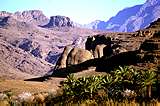
That night's camp was at the end of the long and winding road, That kind of track proved to be the exception and much of our route followed mule tracks except when we made diversions to climb things when tracks were generally nonexistent. This part of Morocco is suffering a severe drought, having had no significant precipitation since March 2002. The river bed on the right was completely dry and wells had been dug into the gravel to reach water for drinking and irrigation. In the distance are our hills. In the evening shadows the temperature plummeted under a clear sky and at night there were more stars than I ever knew existed. For dinner we would congregate in the mess tent where, amidst much banter and hilarity Hussan and Mohammed would serve out the evening meal. Later in the trip we were instructed on how to count in the Berber language. I once got as far as five but having forgotten it all next evening had to forfeit a second helping of pudding! It's only recently that the Berber language has been written down.
Day by day the scenery became more interesting, left is a telephoto shot taken from our first campsite showing some of the day's route into the hills. The white trees in the foreground are Almonds in blossom. For a while we walked along the sides of cultivated fields and little irrigation systems and on leaving the oasis we crunched along dry river beds and over low rocky cols separation one dry river system with another. Much of the terrain seemed to comprise layers of sediments with some impressive though terminally unstable escarpments. Next day we had the option of climbing Jebel Amlal, 1000m of ascent from the camp to the summit of Jebel Sahro's second highest summit at 2460m. The peak was a fairly unspectacular lump of boulders and prickly bushes, but from the top there were distant views of the snowy High Atlas on the western skyline. The summit provided a conveniently flat area for a picnic of thin bread, cheese and tuna, finished off with delicious Moroccan oranges.
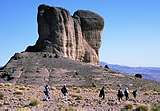
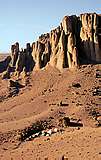
On day 4 (I think), trekking past the impressive Camel's head (top) and Elephant's head rocks. These seemed to be made of conglomerate, a different rock but hardly the better for it. The rocks which looked to be 200m+ were not thought to have been climbed. One evening at the campsite of The Ridge of Fingers (lower), surrounded by a panorama of stunning pinnacles I put on a pair of rock shoes and found a large boulder to call my own. Despite appearances the rock quality was disappointing and I was frequently surprised by its unreliability. The conglomerate pebbles seemed to be very poorly attached to the matrix and it was more by good luck than good judgment that I managed to avoid landing flat on my back in a thicket of Hedgehog Broom. The porters were highly amused by my antics and demonstrated how to do all my best boulder problems in bare feet.
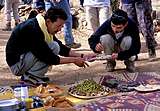
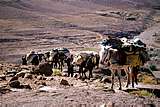
Picture top shows Hassan and Mohammed our guides preparing lunch. This was usually a simple meal of salad and pasta, with oranges to finish. The lunch mule would usually be ahead of us in the morning allowing the carpets to be laid and the water to be on the boil. With a bit of luck there was also half an hour allocated to lying in the sun.
Lower picture shows part of our mule train. The heavily laden animals would doggedly plod the trails, laden with tents, luggage, food, water and a huge haystack of food for themselves, encouraged by the songs? and shouts of the muleteers Ali and Little Ali. It's a tough life being a mule, I suspect that their active life is only a few years. The mules and muleteers would often take a different route from us, arriving an hour or so in advance.

Most of the camp sites were idyllic and far away from habitation, and many of us felt that we could have stayed several days to explore the surrounding countryside. Steeped in blood and history is the mountain of Bou Gaffer. Here in 1934, the Berbers made a historic last stand against the French. Doomed to failure, the impregnable rocks were without water or support. Most of us made a morning ascent of one of its craggy pinnacles; somewhat reminiscent of a Crib Goch in Wales it was an easy scramble though one requiring hands and feet and just a bit of confidence. Picture 9, there we are on one of the tops of which there seemed to be at least five.
Back row L to R is me, Ray Whiting, Bob Roe, Ros Love, Phil Stocks, Mal Roe, Camilla Smith, Jon Stanton; front is Sue, Cathy Watson, Donna Casella, and Gilly Body. Photo by Hassan.
All good things must come to an end, and I think that after 10 day's of trekking most of us were ready for a shower, a normal bed instead of a sleeping bag, and a flush toilet. Day 12 we crossed the pass of Tizi-n-Oulili where part of the team split off for an ascent of Tenemlalt, the highest peak in Jebel Sahro. Unfortunately the very top is restricted to military personnel. I dipped out of that team, having suffered a nasty stomach bug a few days earlier and still feeling a bit weak. By all accounts however it was well worth the effort. Camp was at the road head at Iknioun and by 9 am next morning we were on our minibus on the way back to Marrakech.

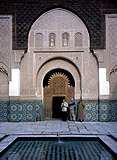
No travelogue of Morocco is complete without reference to the souk, the markets in a labyrinth of old streets where it's very easy to get lost (we had a guide) and the old open air market Djemaa El Fna which is surrounded by terraced cafes and views of the High Atlas. We arrived at the end of a holiday period so things weren't quite as hectic as they might have been. Fortunately.
Picture top , a shoe shop where, despite much deliberation Bob remained unable to decide on a pair of slippers, apparently the toes were all a bit too pointy. No satisfying some people.
Picture middle is the inside the Madersa Ben Youssef an ancient Koranic school. Despite the many tourists (including us) the school had an air of peace about it. Note the beautiful carvings and mosaics. Some of the detail was taken from pages of the Koran.
Team members were:
Serena Nuttall, Philip Stocks, Rosalind (Ros) Love, Ray Whiting, Robert (Bob) Roe, Marilyn (Mal) Roe, Chris Jackson (me), Sue (Suzy) Jackson, Gillian (Gilly) Body, Donna (American) Casella, Catherine (Cathy) Watson, Richard Walters, Camilla Smith, Jon Stanton, Donna (Oz) O'Kearne, Guides Hassan and Mohammed.
Thanks Exodus, excellent trip, good crowd and an unforgettable experience.
chris.jackson@zen.co.uk